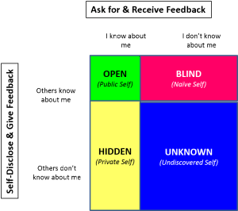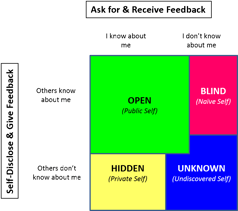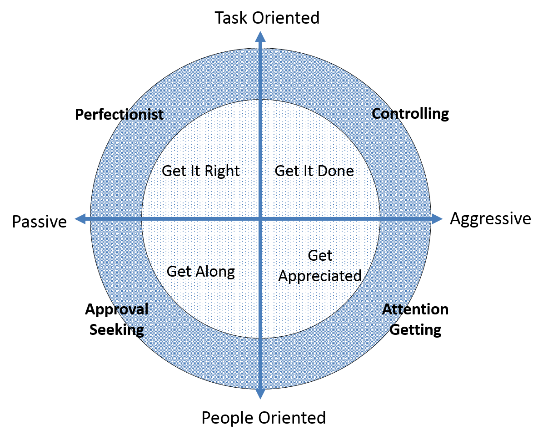
As coaches, we help teams grow and mature. Mature, effective teams understand each other – who they are, what they’re good at, what they’re not, what makes them laugh, what makes them cry, how they think, their intentions, their hopes, and their fears.
In my last blog, I talked about the Johari Window as a simple and intuitive model which can help increase self-awareness, and improve communication and interpersonal relationships. It provides a way to visualize and understand how and in what ways we interact with ourselves and with others.
The Johari Window of a new team looks like Figure 1 on the left below, with a small Open area (public self) because team members haven’t had a chance to share much about themselves.
The Johari Window of a maturing team looks like Figure 2 on the right above, with an expanded Open area.
We can help a team go from a profile like the one on the left to a profile like the one on the right by providing opportunities and encouraging team members to engage in:
- Sharing information about themselves – expanding their Open area vertically and a reducing their Hidden area
- Giving feedback to each other – expanding their Open area horizontally and reducing their Blind area
- Discovering new information about themselves – expanding their Open area diagonally, and reducing their Unknown area
One place we can encourage that level of communication and interaction is in a team retrospective.
Introspective Retrospectives
I think of team retrospectives as 2 general types – those that focus on how we did our work, and those that focus on how we work together.
The first type centers on the process of doing work and how the team can improve their process. The second type explicitly focuses on interactions and communications and how the team can improve the way they work together. I call this second type an “introspective”.
As teams mature, these two types evolve into one, because the team will naturally begin to incorporate discussions about interactions and relationships as needed. But for new teams, or teams with low trust, dedicated introspectives can often help them improve their interactions and team climate.
Opening the Window….with the Lens of Understanding
 There are many tools, activities, and techniques that can be used to help a team expand their Open area. A favorite of mine is to conduct an introspective using the “Lens of Understanding”.
There are many tools, activities, and techniques that can be used to help a team expand their Open area. A favorite of mine is to conduct an introspective using the “Lens of Understanding”.
As shown in Figure 3, the Lens of Understanding is a 4-quadrant model developed by Dr Rick Brinkman and Dr Rick Kirschner as a way to help understand behavior and what drives it.
In this model, the vertical axis indicates the focus of attention – is it on the TASK or on PEOPLE. The horizontal axis indicates level of assertiveness – is it PASSIVE or AGGRESSIVE.
The premise behind this model is that people behave based on their intent. By understanding the intents that drive behavior, we can better understand our own behavior and that of others.
In Figure 4, the Lens of Understanding describes four intents that shape behavior: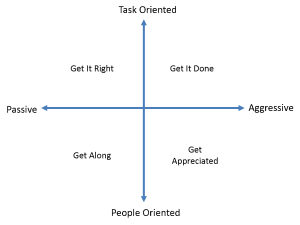
Get it done – if our focus is on getting something done, we tend to speed up vs slow down, act vs deliberate, and assert vs withdraw.
Get it right – if our focus is on getting it right, we tend to slow things down in order to see details. We become absorbed in the task at hand and will likely deliberate before taking any sudden actions.
Get along – when we want everyone to get along, we tend to be less assertive as we put their needs above our own.
Get appreciated – when we want to get appreciation from people, we tend to be more assertive in order to be seen, heard, and recognized.
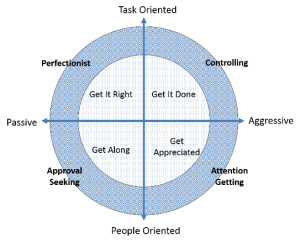 We all have the ability to change where we’re coming from (our intent) based on the context of any given situation. And we each also have a “normal” zone, where we’re most comfortable and exhibit our best behavior.
We all have the ability to change where we’re coming from (our intent) based on the context of any given situation. And we each also have a “normal” zone, where we’re most comfortable and exhibit our best behavior.
As our intent changes, so does our behavior. And when stressed, our normal zone behaviors can become exaggerated, as shown in Figure 5.
For example, let’s say in a particular situation, my intent is to “get it done”, and your intent is to “get it right”. Our intents are at odds with each other, and if we don’t recognize that, or can’t find some middle ground, our stress increases. In this example, my behavior would go toward Controlling, and yours toward Perfectionist.
Being aware of and understanding the intent behind behavior can help us understand and deal with different behaviors.
Using the Lens of Understanding
Below is a description of a retrospective designed around the “Lens of Understanding”.
Purpose:
- Provide a structured opportunity for team members to tell others about themselves, learn how others see them, and generate insights about themselves and others.
Objectives:
- Increase self-awareness of individual behavior
- Increase awareness about others’ behavior
- Expand Open area of each individual and the team as a whole
Supplies:
- Printed copies of the Lens of Understanding matrix (figure 3 above); two copies for each person
- Small stickies, pens, markers
- Masking tape
- Table set-up to accommodate work as individuals and pairs/quads, plus space to roam the room
Open the retrospective meeting
- Open with the check-in, temperature reading, and/or centering activity of your choice
Run the Activity
- Set-up
- Hand out 2 copies of the matrix to each individual; ask them to put their name on each copy
- Each person keep one copy on the table in front of them, and tape the other copy to their back (they’ll need to do this for each otherJ).
- Facilitator draw the basic matrix (Figure 3) on the board and explain what the two axis’ represent
- Self-assess data
- Do this part individually and without showing work to others
- Each person put a mark on their copy of the matrix (the one in front of them) where they think they fall
- For example, mark what quadrant they fall into based on whether they’re generally task oriented, or people oriented; and whether they’re generally passive, or aggressive)
- If they have trouble, it might help to think about a specific work example
- When they’re done, have them turn their copy over on the table in front of them
- NOTE – this can also be done using stickies vs using a marker
- Feedback data
- Everyone roam around the room and on the copy of the matrix on each person’s back, place a mark where they think that person is coming from (based on their observations and experiences with each individual)
- This part may be lively, but ask them to do this without telling each individual where they’re putting their marks
- Everyone take their seats when they’re done
- Introduce additional information about the Lens Of Understanding
- Draw Figures 4 on the board; explain about the four general intents
- Draw Figure 5 on the board; explain how stress can cause exaggerated behaviors
- Each person take a few minutes to look at their two copies – how they see themselves vs how others have indicated they see them
- Discuss learnings in small pairs/quads
- Form pairs or groups of four
- Discuss insights and learnings with others in their pairs/quads
- Debrief at the group level
- aha’s, surprises, shocks, puzzles
- One thing they learned about themselves
- One thing they learned about someone else
- What will change for you on Monday?
Close the retrospective meeting
- Close with the closing/centering activity of your choice
Continuing the Journey
Developing self-awareness and mutual understanding within a team is an on-going journey. Using the Johari Window model, along with thoughtful inclusion of activities like the Lens of Understanding, to help develop a team’s Open area will increase trust and create happier, more collaborative, productive, and successful teams.
Send me your comments…..I’d love to hear what you think and your questions, and your experiences, and ideas for helping teams grow.
More from the blog
View All Blog PostsSubscribe to Our Blog
Fill out your email address to receive notifications about new blog posts from CC Pace!


